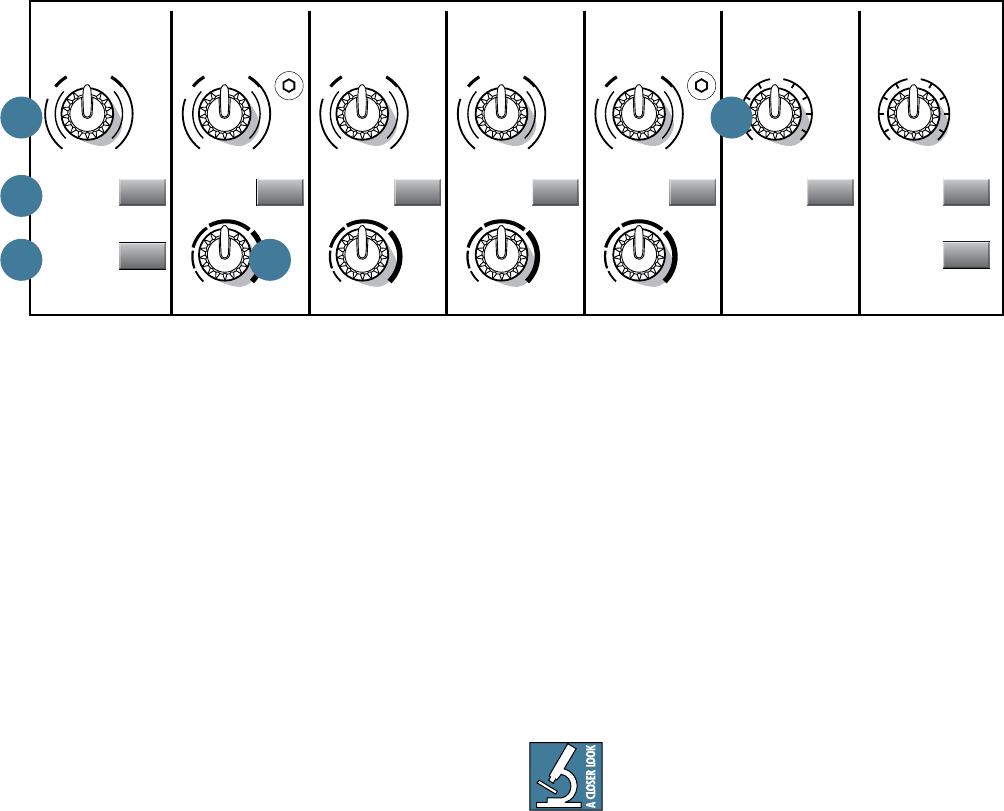
16 VLZ3 4•Bus
GAIN GAIN GAIN GAIN GAIN GAIN
20 21/22 23/2417 18 19
GAIN
16
LOW CUT
100 Hz
18dB/OCT
LOW CUT
100 Hz
18dB/OCT
LOW CUT
100 Hz
18dB/OCT
LOW CUT
100 Hz
18dB/OCT
PAD
-20dB
LOW CUT
100 Hz
18dB/OCT
FX 1
USB
FX 2
U
+20-20
U
+20-20
OFF MAX OFF MAX OFF MAX OFF MAX
COMP COMP COMP COMP
0 60
-45dB+15dB
U
M
I
C
G
A
I
N
-
1
0
d
B
V
M
I
C
G
A
I
N
0 60
-45dB+15dB
U
M
I
C
G
A
I
N
-
1
0
d
B
V
M
I
C
G
A
I
N
0 60
-45dB+15dB
U
M
I
C
G
A
I
N
-
1
0
d
B
V
M
I
C
G
A
I
N
0 60
-45dB+15dB
U
M
I
C
G
A
I
N
-
1
0
d
B
V
M
I
C
G
A
I
N
0 60
-45dB+15dB
U
M
I
C
G
A
I
N
-
1
0
d
B
V
M
I
C
G
A
I
N
Channel Controls
The vertical channel strips look very similar, and
have only a few differences between them. Each
channel works independently, and just controls the
signals plugged into the inputs directly behind it.
“U” like Unity gain
Mackie mixers have a “U” symbol on almost every level
control. It stands for “unity gain,” meaning no change in
signal level. The labels on the controls are measured in
decibels (dB), so you’ll know what you’re doing
level-wise if you choose to change a control’s settings.
23. GAIN CONTROL
If you haven’t already, please read the level-setting
procedure on page 3.
The gain knobs adjust the input sensitivity of the mic
and line inputs. This allows signals from the outside
world to be adjusted to run through each channel at
optimal internal operating levels.
If the signal originates through the mic XLR jack,
there will be 0 dB of gain with the knob fully down,
ramping to 60 dB of gain fully up.
Through the 1⁄4" line input of channels 1-20 (2404-
VLZ3) and channels 1-28 (3204-VLZ3), there is 15 dB of
attenuation fully down and 45 dB of gain fully up, with
unity gain "U" at 10:00.
Through the 1⁄4" line input of channels 21/22 and
23/24 (2404-VLZ3) and 29/30 and 31/32 (3204-VLZ3),
there is 20 dB of attenuation fully down and 20 dB of
gain fully up, with unity gain "U" at 12:00.
This 20 dB of attenuation can be very handy when you
are inserting a hot signal, or when you want to add EQ
gain, or both. Without this “virtual pad,” there is more
chance of channel clipping.
24. LOW CUT
All mono channels have a low-cut switch (often
referred to as a high-pass filter) that cuts bass
frequencies below 100 Hz at a rate of 18 dB per octave.
We recommend that you use low-cut on every
microphone application except kick drum, bass guitar,
or bassy synth patches. These aside, there isn’t much
down there that you want to hear, and filtering it out
makes the low stuff you do want much more crisp and
tasty. Not only that, but low-cut can help reduce the
possibility of feedback in live situations, and it helps to
conserve amplifier power.
Another way to consider low-cut’s function
is that it actually adds flexibility during live
performances. With the addition of low-cut,
you can safely use low equalization on vocals.
Many times, bass shelving EQ can really benefit voices.
Trouble is, adding low EQ also boosts stage rumble, mic
handling clunks and breath pops from way-down low.
Applying low-cut removes all those problems, so you can
add low EQ without blowing your subwoofers.
25. PAD (-20 dB) Switch
In most cases, the pad switch will be disengaged.
However, microphones and balanced line-level signals
that produce a higher output than usual may require
that the gain control [23] is turned way down. If this is
the case, engage the pad switch to allow an additional
20 dB at the input to the mic preamp. This prevents
overloading the microphone preamp and provides better
gain control. The pad only applies to XLR inputs, not the
1/4" TRS inputs.
23
26
23
24
25


















